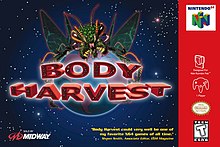
Quake II is a 1997 first-person shooter video game developed by id Software and published by Activision. It is the second installment of the Quake series, following Quake. The game's storyline is continued in its expansions, including one tying in Quake II and the first game, and Quake 4.

Rockstar North Limited is a British video game development company and a studio of Rockstar Games based in Edinburgh. The company was founded as DMA Design in Dundee in 1987 by David Jones, soon hiring former classmates Mike Dailly, Russell Kay, and Steve Hammond. During its early years, DMA Design was backed by its publisher Psygnosis, primarily focusing on Amiga, Atari ST and Commodore 64 games. During this time, they created successful shooters such as Menace and Blood Money, but soon turned to platform games after the release of Lemmings in 1991, which was an international success and led to several sequels and spin-offs. After developing Unirally for Nintendo, DMA Design was set to become one of their main second-party developers, but this partnership ended after Nintendo's disapproval of Body Harvest.

Rock n' Roll Racing is a vehicular combat-based racing video game developed by Silicon & Synapse and published by Interplay Productions for the Super Nintendo Entertainment System in 1993 and the Mega Drive/Genesis in 1994. The game prominently features a number of popular heavy metal and rock songs in its soundtrack, hence the game's title. The game was ported to the Game Boy Advance in 2003. In celebration of the company's 30th anniversary, Rock n' Roll Racing was re-released for Microsoft Windows, Nintendo Switch, PlayStation 4 and Xbox One as part of the Blizzard Arcade Collection in February 2021.

Star Fox 64, known as Lylat Wars in the PAL regions, is a 1997 3D rail shooter video game developed and published by Nintendo for the Nintendo 64. It is the second installment in the Star Fox series and a reboot of the original Star Fox for the Super Nintendo Entertainment System.

Battlezone is a first-person shooter real-time strategy video game, developed and published by Activision. It was released for Microsoft Windows in 1998. Aside from the name and presence of tanks, this game bears little resemblance to the original arcade game of the same name. Activision remade it into a hybrid of a tank simulation game, a first-person shooter and a real-time strategy game. In Battlezone the player is controlling everything on the battlefield from the first person view.

The World Is Not Enough is a first-person shooter video game developed by Eurocom and based on the 1999 James Bond film of the same name. It was published by Electronic Arts and released for the Nintendo 64 on October 17, 2000, shortly before the release of its PlayStation counterpart. The game features a single-player campaign in which players assume the role of secret agent James Bond as he fights to stop a terrorist from triggering a nuclear meltdown in the waters of Istanbul. It includes a split-screen multiplayer mode where up to four players can compete in different types of deathmatch and objective-based games.

Star Fox: Assault is a 3D scrolling shooter and third-person shooter video game developed by Namco and published by Nintendo for the GameCube. It is the fourth released title in the Star Fox series. The game was released on 15 February 2005 in North America, on 24 February 2005 in Japan, on 29 April 2005 in Europe, and on 16 June 2005 in Australia.

Turok 2: Seeds of Evil is a first-person shooter video game developed by Iguana Entertainment and published by Acclaim Entertainment. It was released for the Nintendo 64 console in 1998 and ported to Microsoft Windows computers in 1999. Seeds of Evil is the second game in the Turok video game series and a sequel to Turok: Dinosaur Hunter. The game follows the story of a Turok and his efforts to stop a powerful alien entity from escaping the confines of his Lightship. A different game set in the same fictional universe, also titled Turok 2: Seeds of Evil, was released for the Game Boy Color alongside the Nintendo 64 game.

Vigilante 8 is a vehicular combat video game developed by Luxoflux and published by Activision for PlayStation, Nintendo 64 and Game Boy Color. Although officially it has no connection to the Interstate '76 series, it features several of its themes.

Buck Bumble is an action video game for the Nintendo 64 developed by British video game company Argonaut Software and released by Ubi Soft in 1998. A special Buck Bumble rumble pack was packaged with the U.K. version.

Nightmare Creatures is a 1997 survival horror video game developed by Kalisto Entertainment for PlayStation, Microsoft Windows and Nintendo 64. A sequel, Nightmare Creatures II, was released three years later. A mobile phone version of Nightmare Creatures was developed and published by Gameloft in 2003. A second sequel, Nightmare Creatures III: Angel of Darkness, was cancelled in 2004.

Hybrid Heaven is a video game developed by Konami Computer Entertainment Osaka and released for the Nintendo 64 in 1999. This game is most notable for its peculiar mix of genres: it has aspects of both role-playing video games and action-adventure games. It is also one of the few Nintendo 64 titles to support a widescreen mode.

Space Station Silicon Valley is a platform video game developed by DMA Design and published by Take-Two Interactive. It was originally released for the Nintendo 64 in October 1998. An adaptation of the game for Game Boy Color was developed by Tarantula Studios and released in 1999. A PlayStation port, developed by Runecraft, was released in 2000, under the name Evo's Space Adventures. Players control Evo, a robot reduced to a crawling microchip after a ship crash, and are tasked with taking control of animals to solve puzzles and defeat enemies.
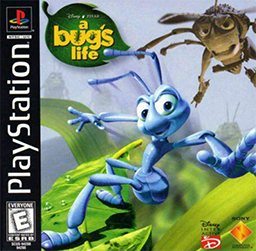
A Bug's Life is a video game based on the Disney/Pixar 1998 film of the same name. It was released for various systems in 1998 and in 1999. The game's storyline is similar to that of the film, with a few changes. After completing levels the player can unlock clips from the film. The PlayStation version was released on the PlayStation Store for the PlayStation 3 and PlayStation Portable on July 27, 2010.
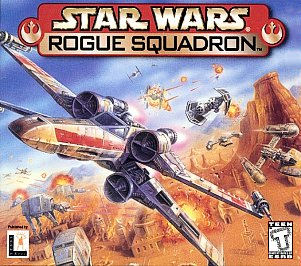
Star Wars: Rogue Squadron is an arcade-style flight action game co-developed by Factor 5 and LucasArts. The first of three games in the Rogue Squadron series, it was published by LucasArts and Nintendo and released for Microsoft Windows and Nintendo 64 in December 1998. The game's story was influenced by the Star Wars: X-wing – Rogue Squadron comics and is set in the fictional Star Wars galaxy, taking place primarily between events in the films Star Wars and The Empire Strikes Back. The player controls Luke Skywalker, commander of the elite X-wing pilots known as Rogue Squadron. As the game progresses, Skywalker and Rogue Squadron fight the Galactic Empire in 16 missions across various planets.

A Grand Theft Auto clone is a subgenre of open world action-adventure video games, characterized by their likeness to the Grand Theft Auto series in either gameplay, or overall design. In these types of open world games, players may find and use a variety of vehicles and weapons while roaming freely in an open world setting. The objective of Grand Theft Auto clones is to complete a sequence of core missions involving driving and shooting, but often side-missions and minigames are added to improve replay value. The storylines of games in this subgenre typically have strong themes of crime, violence and other controversial elements such as drugs and sexually explicit content.

Armorines: Project S.W.A.R.M., known as Armorines in Europe, is a 1999 first-person shooter developed by Acclaim Studios London and released for the Nintendo 64, Game Boy Color and PlayStation. It is based on the Armorines comic book from Valiant Comics, which was bought by Acclaim Entertainment.

Grand Theft Auto is an action-adventure video game developed by DMA Design and published by BMG Interactive. It is the first title of the Grand Theft Auto series and was released in November 1997 for MS-DOS and Microsoft Windows, in December 1997 for the PlayStation and in October 1999 for the Game Boy Color. The game's narrative follows a criminal who climbs in status within the criminal underworld across three fictional cities, inspired by real-life locations. The gameplay is presented from a top-down perspective and takes place within an open-world environment in which the player is required to gather a certain number of points to progress through the game's chapters. Said points are gathered by completing various missions throughout each city, although the player can gather the points through other means as well.
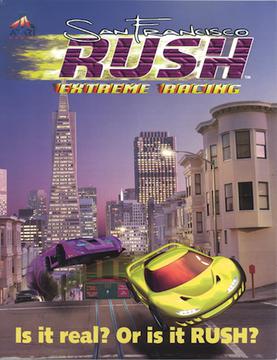
San Francisco Rush: Extreme Racing is a video game developed and published by Atari Games. This game was first released in arcades in 1996 and was ported to Nintendo 64 in 1997 and the PlayStation in 1998. San Francisco Rush: Extreme Racing is the first game in the Rush series.
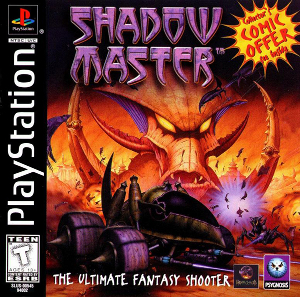
Shadow Master is a video game developed by HammerHead and published by Psygnosis for the PlayStation and Microsoft Windows. It is a first-person shooter in which the player character rides in an armed vehicle. It met with predominantly negative reviews which praised its visuals but criticized it for clunky controls and poorly designed, frustrating gameplay.
